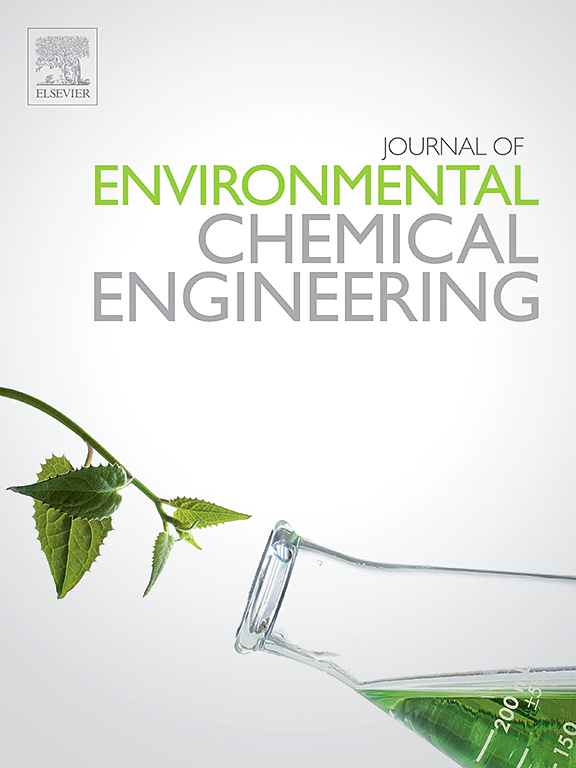Induced crystallization techniques for fluoride removal from wastewater: Current developments and applications
IF 7.2
2区 工程技术
Q1 ENGINEERING, CHEMICAL
引用次数: 0
Abstract
Excessive fluoride in wastewater poses significant risks to ecosystems and human health. Crystallization methods, including cryolite, calcium fluoride, and fluorapatite, demonstrate high fluoride removal efficiency (>90 %) under optimized conditions and offer the added benefit of resource recovery. Maintaining an optimal pH range (5−7) after chemical dosing enhances removal efficiency, though sulfate interference remains a limiting factor. CaF2 and FAP typically crystallize at ambient temperature, with molar ratios of Ca/F= 0.6–0.7 and Ca:P:F= 10:4:1, respectively. In contrast, Na3AlF6 crystallization performs best at 20–50°C with an Al/F ratio of 1:6. While the small-scale research on the crystallization methods of the three products is in full swing, only the CaF2 crystallization has been comprehensively applied in pilot-scale trials and full-scale engineering. Na3AlF6 crystallization is currently at the pilot-scale stage, whereas FAP crystallization has made no progress during the small-scale stage. Each method faces specific challenges. CaF2 crystallization requires improvements in product purity and effluent quality. FAP crystallization needs effective phosphate control and cost-efficient reactor design. Na3AlF6 must balance product purity with fluoride removal efficiency. Future research should prioritize the optimization of operational parameters, cost reduction, and the development of practical applications for novel approaches to facilitate large-scale implementation.
诱导结晶技术去除废水中的氟化物:目前的发展和应用
废水中过量的氟化物对生态系统和人类健康构成重大风险。结晶方法,包括冰晶石、氟化钙和氟磷灰石,在优化条件下表现出较高的除氟效率(>90 %),并提供了资源回收的附加效益。化学投加后保持最佳pH范围(5 - 7)可以提高去除效率,但硫酸盐干扰仍然是一个限制因素。CaF2和FAP通常在常温下结晶,Ca/F的摩尔比分别为 0.6-0.7和Ca:P:F= 10:4:1。相反,Na3AlF6在20-50℃、Al/F比为1:6时结晶效果最好。目前,三种产品的结晶方法的小规模研究正在如火如荼地进行,只有CaF2结晶在中试和工程上得到了全面的应用。Na3AlF6结晶目前处于中试阶段,而FAP结晶在小规模阶段没有取得进展。每种方法都面临着特定的挑战。CaF2结晶需要提高产品纯度和出水质量。FAP结晶需要有效的磷酸盐控制和经济高效的反应器设计。Na3AlF6必须平衡产品纯度和除氟效率。未来的研究应优先考虑操作参数的优化、成本的降低和新方法的实际应用的发展,以促进大规模实施。
本文章由计算机程序翻译,如有差异,请以英文原文为准。
求助全文
约1分钟内获得全文
求助全文
来源期刊

Journal of Environmental Chemical Engineering
Environmental Science-Pollution
CiteScore
11.40
自引率
6.50%
发文量
2017
审稿时长
27 days
期刊介绍:
The Journal of Environmental Chemical Engineering (JECE) serves as a platform for the dissemination of original and innovative research focusing on the advancement of environmentally-friendly, sustainable technologies. JECE emphasizes the transition towards a carbon-neutral circular economy and a self-sufficient bio-based economy. Topics covered include soil, water, wastewater, and air decontamination; pollution monitoring, prevention, and control; advanced analytics, sensors, impact and risk assessment methodologies in environmental chemical engineering; resource recovery (water, nutrients, materials, energy); industrial ecology; valorization of waste streams; waste management (including e-waste); climate-water-energy-food nexus; novel materials for environmental, chemical, and energy applications; sustainability and environmental safety; water digitalization, water data science, and machine learning; process integration and intensification; recent developments in green chemistry for synthesis, catalysis, and energy; and original research on contaminants of emerging concern, persistent chemicals, and priority substances, including microplastics, nanoplastics, nanomaterials, micropollutants, antimicrobial resistance genes, and emerging pathogens (viruses, bacteria, parasites) of environmental significance.
 求助内容:
求助内容: 应助结果提醒方式:
应助结果提醒方式:


